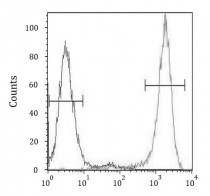ARG55572
anti-eIF4E antibody [163CT48.1.9]
anti-eIF4E antibody [163CT48.1.9] for Flow cytometry,Western blot and Human,Mouse
Gene Regulation antibody
Overview
| Product Description | Mouse Monoclonal antibody recognizes eIF4E |
|---|---|
| Tested Reactivity | Hu, Ms |
| Tested Application | FACS, WB |
| Host | Mouse |
| Clonality | Monoclonal |
| Clone | 163CT48.1.9 |
| Isotype | IgG1, kappa |
| Target Name | eIF4E |
| Antigen Species | Human |
| Immunogen | Recombinant protein of Human eIF4E. |
| Conjugation | Un-conjugated |
| Alternate Names | EIF4E1; EIF4EL1; Eukaryotic translation initiation factor 4E; eIF-4F 25 kDa subunit; mRNA cap-binding protein; CBP; eIF-4E; eIF4E; AUTS19; EIF4F |
Application Instructions
| Application Suggestion |
|
||||||
|---|---|---|---|---|---|---|---|
| Application Note | * The dilutions indicate recommended starting dilutions and the optimal dilutions or concentrations should be determined by the scientist. | ||||||
| Positive Control | Jurkat |
Properties
| Form | Liquid |
|---|---|
| Buffer | Crude Ascites and 0.09% (W/V) Sodium azide |
| Preservative | 0.09% (W/V) Sodium azide |
| Storage Instruction | For continuous use, store undiluted antibody at 2-8°C for up to a week. For long-term storage, aliquot and store at -20°C or below. Storage in frost free freezers is not recommended. Avoid repeated freeze/thaw cycles. Suggest spin the vial prior to opening. The antibody solution should be gently mixed before use. |
| Note | For laboratory research only, not for drug, diagnostic or other use. |
Bioinformation
| Database Links |
Swiss-port # P06730 Human Eukaryotic translation initiation factor 4E Swiss-port # P63073 Mouse Eukaryotic translation initiation factor 4E |
|---|---|
| Gene Symbol | EIF4E |
| Gene Full Name | eukaryotic translation initiation factor 4E |
| Background | The protein encoded by this gene is a component of the eukaryotic translation initiation factor 4F complex, which recognizes the 7-methylguanosine cap structure at the 5' end of messenger RNAs. The encoded protein aids in translation initiation by recruiting ribosomes to the 5'-cap structure. Association of this protein with the 4F complex is the rate-limiting step in translation initiation. This gene acts as a proto-oncogene, and its expression and activation is associated with transformation and tumorigenesis. Several pseudogenes of this gene are found on other chromosomes. Alternative splicing results in multiple transcript variants. [provided by RefSeq, Sep 2015] |
| Function | Recognizes and binds the 7-methylguanosine-containing mRNA cap during an early step in the initiation of protein synthesis and facilitates ribosome binding by inducing the unwinding of the mRNAs secondary structures. Component of the CYFIP1-EIF4E-FMR1 complex which binds to the mRNA cap and mediates translational repression. In the CYFIP1-EIF4E-FMR1 complex this subunit mediates the binding to the mRNA cap. [UniProt] |
| Cellular Localization | Cytoplasm, P-body. Cytoplasm |
| Research Area | Gene Regulation antibody |
| Calculated MW | 25 kDa |
| PTM | Phosphorylation increases the ability of the protein to bind to mRNA caps and to form the eIF4F complex. |
Images (2) Click the Picture to Zoom In
-
ARG55572 anti-eIF4E antibody WB image
Western blot: 15 µg of Jurkat cell lysate stained with ARG55572 anti-eIF4E antibody.
-
ARG55572 anti-eIF4E antibody FACS image
Flow Cytometry: Jurkat cells stained with ARG55572 anti-eIF4E antibody (right histogram) or without primary antibody as control (left histogram), followed by incubation with FITC labelled secondary antibody.







